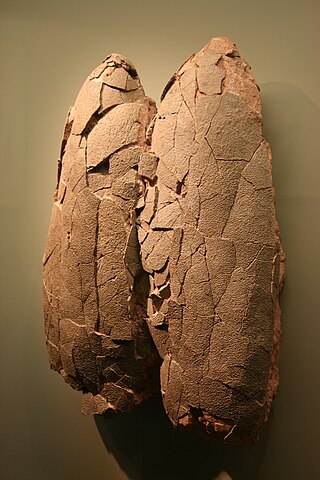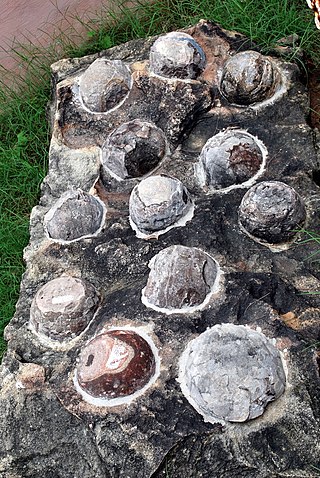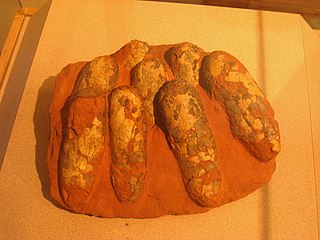
Oviraptor is a genus of oviraptorid dinosaur that lived in Asia during the Late Cretaceous period. The first remains were collected from the Djadokhta Formation of Mongolia in 1923 during a paleontological expedition led by Roy Chapman Andrews, and in the following year the genus and type species Oviraptor philoceratops were named by Henry Fairfield Osborn. The genus name refers to the initial thought of egg-stealing habits, and the specific name was intended to reinforce this view indicating a preference over ceratopsian eggs. Despite the fact that numerous specimens have been referred to the genus, Oviraptor is only known from a single partial skeleton regarded as the holotype, as well as a nest of about fifteen eggs and several small fragments from a juvenile.

Byronosaurus is a genus of troodontid dinosaur from the Late Cretaceous Period of Mongolia.

Nemegtomaia is a genus of oviraptorid dinosaur from what is now Mongolia that lived in the Late Cretaceous Period, about 70 million years ago. The first specimen was found in 1996, and became the basis of the new genus and species N. barsboldi in 2004. The original genus name was Nemegtia, but this was changed to Nemegtomaia in 2005, as the former name was preoccupied. The first part of the generic name refers to the Nemegt Basin, where the animal was found, and the second part means "good mother", in reference to the fact that oviraptorids are known to have brooded their eggs. The specific name honours the palaeontologist Rinchen Barsbold. Two more specimens were found in 2007, one of which was found on top of a nest with eggs, but the dinosaur had received its genus name before it was found associated with eggs.

Caenagnathidae is a family of derived caenagnathoid dinosaurs from the Cretaceous of North America and Asia. They are a member of the Oviraptorosauria, and relatives of the Oviraptoridae. Like other oviraptorosaurs, caenagnathids had specialized beaks, long necks, and short tails, and would have been covered in feathers. The relationships of caenagnathids were long a puzzle. The family was originally named by Raymond Martin Sternberg in 1940 as a family of flightless birds. The discovery of skeletons of the related oviraptorids revealed that they were in fact non-avian theropods, and the discovery of more complete caenagnathid remains revealed that Chirostenotes pergracilis, originally named on the basis of a pair of hands, and Citipes elegans, originally thought to be an ornithomimid, named from a foot, were caenagnathids as well.

Elongatoolithus is an oogenus of dinosaur eggs found in the Late Cretaceous formations of China and Mongolia. Like other elongatoolithids, they were laid by small theropods, and were cared for and incubated by their parents until hatching. They are often found in nests arranged in multiple layers of concentric rings. As its name suggests, Elongatoolithus was a highly elongated form of egg. It is historically significant for being among the first fossil eggs given a parataxonomic name.
Protoceratopsidovum is an oogenus of dinosaur egg from Mongolia. Despite its name, it does not represent the eggs of a protoceratopsid, but rather the eggs of maniraptoran theropods.

Macroelongatoolithus is an oogenus of large theropod dinosaur eggs, representing the eggs of giant caenagnathid oviraptorosaurs. They are known from Asia and from North America. Historically, several oospecies have been assigned to Macroelongatoolithus, however they are all now considered to be a single oospecies: M. carlylensis.

Macroolithus is an oogenus of dinosaur egg belonging to the oofamily Elongatoolithidae. The type oospecies, M. rugustus, was originally described under the now-defunct oogenus name Oolithes. Three other oospecies are known: M. yaotunensis, M. mutabilis, and M. lashuyuanensis. They are relatively large, elongated eggs with a two-layered eggshell. Their nests consist of large, concentric rings of paired eggs. There is evidence of blue-green pigmentation in its shell, which may have helped camouflage the nests.
Continuoolithus is an oogenus of dinosaur egg found in the late Cretaceous of North America. It is most commonly known from the late Campanian of Alberta and Montana, but specimens have also been found dating to the older Santonian and the younger Maastrichtian. It was laid by an unknown type of theropod. These small eggs are similar to the eggs of oviraptorid dinosaurs, but have a distinctive type of ornamentation.

Egg fossils are the fossilized remains of eggs laid by ancient animals. As evidence of the physiological processes of an animal, egg fossils are considered a type of trace fossil. Under rare circumstances a fossil egg may preserve the remains of the once-developing embryo inside, in which case it also contains body fossils. A wide variety of different animal groups laid eggs that are now preserved in the fossil record beginning in the Paleozoic. Examples include invertebrates like ammonoids as well as vertebrates like fishes, possible amphibians, and reptiles. The latter group includes the many dinosaur eggs that have been recovered from Mesozoic strata. Since the organism responsible for laying any given egg fossil is frequently unknown, scientists classify eggs using a parallel system of taxonomy separate from but modeled after the Linnaean system. This "parataxonomy" is called veterovata.
Sankofa is an oogenus of prismatoolithid egg. They are fairly small, smooth-shelled, and asymmetrical. Sankofa may represent the fossilized eggs of a transitional species between non-avian theropods and birds.

This timeline of oviraptorosaur research is a chronological listing of events in the history of paleontology focused on the oviraptorosaurs, a group of beaked, bird-like theropod dinosaurs. The early history of oviraptorosaur paleontology is characterized by taxonomic confusion due to the unusual characteristics of these dinosaurs. When initially described in 1924 Oviraptor itself was thought to be a member of the Ornithomimidae, popularly known as the "ostrich" dinosaurs, because both taxa share toothless beaks. Early caenagnathid oviraptorosaur discoveries like Caenagnathus itself were also incorrectly classified at the time, having been misidentified as birds.

Elongatoolithidae is an oofamily of fossil eggs, representing the eggs of oviraptorosaurs. They are known for their highly elongated shape. Elongatoolithids have been found in Europe, Asia, and both North and South America.
Undulatoolithus is an oogenus of Chinese fossil dinosaur egg belonging to Elongatoolithidae. It is very similar to Macroolithus, but has different ornamentation. Like other elongatoolithids, it was probably laid by oviraptorosaurs.
Tubercuoolithus is an oogenus of dinosaur egg from the early Campanian of Montana.
Triprismatoolithus is an oogenus of dinosaur egg native to Teton County, Montana. It is classified in the oofamily Arriagadoolithidae, the eggs of alvarezsaurs.

Gobioolithus is an oogenus of fossil bird egg native to Mongolia. They are small, smooth-shelled, and elongated eggs that were first discovered in the 1960s and early 70s during a series of fossil-hunting expeditions in the Gobi desert. Two oospecies have been described: Gobioolithus minor and G. major. The eggs were probably laid in colonial nesting sites on the banks of rivers and lakes.
Pachycorioolithus is an oogenus of small, thin-shelled fossil egg from the early Cretaceous in China. It probably belongs to a bird, though there is a possibility the parent was a non-avian theropod. It was named in 2016, based on a single specimen found in Zhejiang.

Beibeilong is a genus of large caenagnathid dinosaurs that lived in Asia during the Late Cretaceous epoch, about 96 million to 88 million years ago. The genus contains a single species, Beibeilong sinensis. The species was named and described in 2017 through analysis of an embryonic skeleton and partial nest with large eggs that were discovered in the Gaogou Formation of China between 1992 and 1993.
Gannanoolithus is an oogenus of dinosaur eggs likely laid by a dromaeosaurid theropod. It contains a single oospecies, G. yingliangi, known from the Late Cretaceous (Maastrichtian) Lianhe Formation of Jiangxi Province, China.











